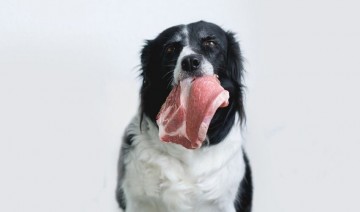
Considering Raw Food for Your Pet?
It can be tempting to feed your pet a raw food diet, but is it the safest, healthiest option? Understanding what raw food means for cats and dogs and how to prepare a raw food diet properly can help you choose the best meals for your pet.
What a Raw Food Diet Really Is
A raw food diet is fresh, untreated, uncooked food, typically offered as a blended diet that includes meat, fruits, and vegetables. Raw food diets mimic the diets of our pets’ wild ancestors, when the animals not only hunted a variety of prey for themselves, but also scavenged for scraps from other animals’ hunts or available refuse from human settlements. These diets are customized for each animal’s specific nutritional needs, but will typically include…
- Raw muscle meat, occasionally still on the bone
- Bones, either whole or ground
- Organ meats, such as kidneys and liver
- Raw eggs
- Small quantities of vegetables and fruits
While a raw food diet is a sound idea, it is important to note that today’s pets have very different physiology and lifestyles than their wild ancestors. Along with the evolution that has created dramatically different dog and cat breeds, their nutritional needs and digestive processes have also evolved. Raw food must be treated very carefully and monitored closely to be sure it is meeting a pet’s needs and providing a balanced, comprehensive diet.
Pros and Cons of Raw Food for Your Pet
There are many pros and cons to a raw food diet for cats and dogs. While there is little long term, scientific study on the impact of a raw food diet, advocates of this nutritional plan have noted different benefits such as…
- Improved overall health, including healthier skin and coat, cleaner teeth, fresher breath, and more energy
- Smaller stools due to better digestion of raw foods as opposed to filler grains, and stools may have less odor
- Better knowledge of what’s in a pet’s diet, including eliminating fillers such as meat byproducts, excess grains, and artificial preservatives
It is also easier to adjust a pet’s raw food diet to accommodate changes in nutritional needs as the animal ages or if different health concerns arise. This gives pet owners more flexibility in feeding their pet and making any necessary changes with as little dietary difficulty as possible.
A raw food diet does have several potential problems, however. Before switching to raw food, pet owners should carefully consider these added difficulties.
- Greater prevalence of bacteria in raw meat that can cause illness, not just to pets but also to the humans preparing the food
- Long term nutritional deficiencies because of an overall dietary imbalance, which can lead to illnesses, bone deformities, or improper growth
- Risk of injury from whole or partial bones, including broken teeth, internal injuries from sharp bone fragments, choking, and constipation
- Greater expense to prepare a raw food diet, as well as the time and storage space necessary to prepare and keep quantities of food on hand for easy feeding
Every pet owner considering raw food for their pets will need to carefully weigh the pros and cons of the diet before switching their pet’s food.
Is Raw Food Right for Your Pet?
Raw food diets have long been popular with racing dogs, including sled dogs and greyhounds. Pets with strong dietary allergies and health problems related to nutrition could also benefit from a carefully prepared raw food diet. The animal’s age, activity level, breed, and overall health will also impact whether or not a raw food diet is a good choice. Every pet’s needs are different, as are every owner’s considerations, and the best diet for one pet may not necessarily be the best diet for another pet, even in the same household. It is always best to consult a veterinarian about dietary and nutritional needs before switching foods, including transitioning to a raw food diet.
Offering Your Pet a Raw Food Diet
If a raw food diet does look promising for your pet, there are different options to choose from. Some pet owners will prepare the entire diet themselves, using grocery store meats and produce or finding alternative food sources such as directly purchasing supplies from hunters, butchers, meat processing facilities, or farms, or even hunting and growing their pet’s food themselves. Commercially processed raw food is also available in refrigerated, frozen, or freeze-dried varieties, which can then be offered to a pet or blended with additional components, such as small quantities of grain or vegetables. Some diets also require meat to be added before feeding, depending on the overall composition of the food blend.
It is critical to be vigilant when preparing a pet’s raw food diet. Clean hands, utensils, work surfaces, and bowls or storage containers are essential to minimize the risk of bacteria that can cause grave illnesses. The diet will need to be carefully balanced to provide the proper nutrition for the pet, and that balance may change as the pet’s dietary needs change. A diverse diet is best and will provide more trace vitamins and minerals for the pet, though supplemental vitamins may still be necessary.
Above all, a pet owner needs to stay alert to their pet’s health changes. While some digestive difficulty is normal when switching foods or changing to a new diet, severe or prolonged problems such as diarrhea, vomiting, or overall refusal to eat are alarming signs that should be brought to a veterinarian’s attention.
A raw food diet can be a viable option for some pets, but it isn’t always the best choice for every animal or every pet owner. By understanding the diet thoroughly, including how it must be prepared and the challenges it can present, pet owners can decide if raw food is a good option for themselves and their pet.
